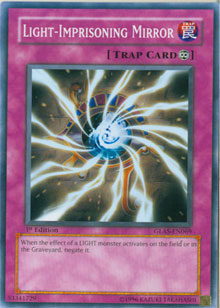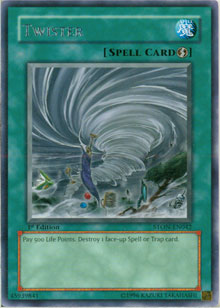In the years that I have been playing the Yu-Gi-Oh! TCG, I’ve noticed that the majority of players have more difficulty using their side decks effectively than they have playing their main decks. The importance of the side deck is often understated, and even some of the best players in the game tend to focus on their main decks significantly more than their side decks. The side deck only contains fifteen cards, all of which are irrelevant in game 1 of every match. But those fifteen cards are critical in games 2 and 3, and effective side decking often means the difference between victory and defeat. It’s important to have a side-deck strategy before entering any tournament in order to optimize use of those fifteen side-deck slots and gain every advantage possible over the popular decks in the environment.

Constructing a Side Deck
For instance, Non-Fusion Area would be a great card against an Elemental Hero deck. It prevents the summoning of all Elemental Hero Fusions by shutting down cards like Polymerization, Fusion Gate, and Miracle Fusion. But how many Elemental Hero decks do you expect to play against in a tournament? And of those, how many actually pose a threat to the deck you’re running? I can’t remember the last time someone tried to summon an Elemental Hero Wildedge against me in a tournament. In a Regional or Shonen Jump tournament, you’ll most likely encounter very few Elemental Hero decks, and of the ones you compete against, even fewer (perhaps none at all) will be more difficult to beat than Teleport Dark Armed Dragon, Lightsworn, or Zombies. As a result, it would be more beneficial over the course of the tournament to use the side deck to prepare for these more frequent and more difficult matchups, instead of making an easy match win even easier.
When constructing a side deck, it’s also important to keep in mind that you must remove the exact same number of cards from your main deck that you add in from your side deck. This means that even if a certain matchup is highly unfavorable for your deck, it might not necessarily be a good idea to devote all fifteen card slots to that matchup. For example, suppose you’re running a Lightsworn deck and the TeleDAD matchup concerns you most. There are several great cards against TeleDAD, including Shadow-Imprisoning Mirror, Compulsory Evacuation Device, Phoenix Wing Wind Blast, Thunder King Rai-Oh, and D.D. Crow. But if you put three of each of these cards into your side deck with the intention of using them all every time you play against a TeleDAD deck, you would need to remove fifteen cards from your main deck each time. That’s nearly impossible to do without ruining the natural synergy that makes a Lightsworn deck so competitive. As a result, while constructing your side deck, it is necessary for you to determine exactly how many cards you can remove from your main deck without ruining its synergy for each matchup. This way, the added tech from the side deck can make the match more favorable against TeleDAD, instead of just slowing down one of the fastest decks in the metagame. There’s no reason to have fifteen cards in your side deck just for TeleDAD if there are only four cards that you’re willing to remove from your main deck between games. In general, players only want to side deck a few cards for each matchup and want to be well-prepared to play against any deck.
Bait and Switch: The Transformational Side Deck
Of course, there are always exceptions. In the past, several competitive decks have emerged that sided in fifteen cards (or close to fifteen cards) after game 1, completely changing the way the deck runs in game 2. At several past Shonen Jump Championships, top Burn decks transformed into Monarch decks, and old decks based around Chaos Sorcerer and Return from the Different Dimension transformed into Cyber-Stein OTKs.
There are several advantages to doing this. First of all, your opponent will not know what he or she is playing against in game 2 if you transform your deck after game 1. The lack of that information alone could cause your opponent to make misplays that would only have been good moves against the deck you used in the first duel. Furthermore, the opponent’s side-deck strategy is completely thrown off, since he or she will add cards to the main deck that would only be useful against the deck you were using previously. Cards that were good against your game 1 build might even be completely useless against the game 2 version. When playing against someone with a transformational side deck, it’s especially important to pay attention to the cards that are played throughout the match so that you can prepare for either deck when siding for game 3.
 In recent Shonen Jump tournaments, several TeleDAD decks partially transformed into versions exploiting Skill Drain. This way, the TeleDAD deck can take advantage of cards like Stardust Dragon and Destiny Hero - Malicious, which work in the graveyard, while shutting down opposing effect monsters that resolve on the field. Unprepared to play against this transformed strategy, few duelists who relied heavily on effect monsters that trigger on the field were able to side deck in cards like Dust Tornado in game 2 to destroy the opponent’s face-up Skill Drain. Gradually, this transformational side deck strategy faded out of popularity as more players became aware of its existence and prepared themselves for it (although it’s still viable and still used, as evidenced by recent Shonen Jump Championship Top 16 decklists).
In recent Shonen Jump tournaments, several TeleDAD decks partially transformed into versions exploiting Skill Drain. This way, the TeleDAD deck can take advantage of cards like Stardust Dragon and Destiny Hero - Malicious, which work in the graveyard, while shutting down opposing effect monsters that resolve on the field. Unprepared to play against this transformed strategy, few duelists who relied heavily on effect monsters that trigger on the field were able to side deck in cards like Dust Tornado in game 2 to destroy the opponent’s face-up Skill Drain. Gradually, this transformational side deck strategy faded out of popularity as more players became aware of its existence and prepared themselves for it (although it’s still viable and still used, as evidenced by recent Shonen Jump Championship Top 16 decklists).
Several players began side decking in copies of Dust Tornado or Twister against TeleDAD decks after game 1, in anticipation of the transformational side deck strategy.
For certain decks, it’s extremely important for players to make side-decking decisions in anticipation of a specific side-deck strategy from the opponent. Lightsworn players, for instance, often side deck in Phantom of Chaos or Royal Decree as methods of nullifying opponents’ copies of Light-Imprisoning Mirror after game 1, expecting it to be used against them. This way, they have methods of dealing with the bane of their deck as soon as it hits the field.
Smokescreen Side Decking
To conceal the number of cards they’re side decking between games, some players shuffle their side decks into their main decks and then remove fifteen cards. This is often referred to as "smokescreen" side decking. If you do this, your opponent will have no way of knowing how many cards you actually changed between game 1 and game 2. Fifteen cards could be different, or every main-decked card could be the same. This is most advantageous when using a transformational side deck. While there are no disadvantages to smokescreen side decking, it’s often done by only the most experienced players. It requires a player to know his or her own deck very well and have a well-planned side deck strategy so that he or she can quickly swap out the pertinent fifteen cards entering the next game. Players should frequently practice smokescreen side decking if they plan on doing it in tournaments.
What I’ll Discuss in Future Articles
Side decking isn’t easy. To do so effectively, it’s important to understand how each matchup will typically play out and what cards are most important in each matchup. In order to figure this out, it’s important to be aware of the most viable decks that have been discovered in the format and each of those deck’s weaknesses, whether it’s reducing its field presence or disrupting a combo. While a side deck can be copied from Shonen Jump Championship decklists, a side-deck strategy cannot.
In each of my future articles for this column, I will focus on one competitive deck, and discuss each of its matchups against other competitive decks. I will analyze which commonly played cards in that deck are least effective and can be removed from the main with little consequence, and which cards can be added in their place to provide an edge over the opponent. With some skilled side decking, you may realize that the matchup you dread most can actually be made favorable.
—Michael Kohanim